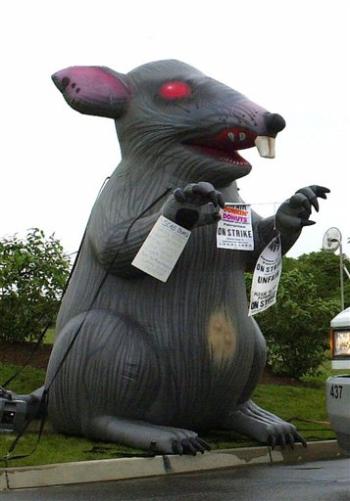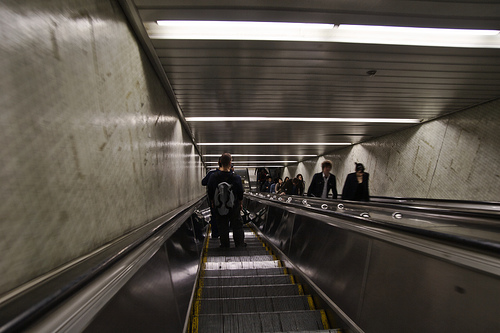
American analog TVs get a reprieve...
As reported by the New York Times, yesterday, the House of Representatives passed a bill extending the date that terrestrial TV stations must stop broadcasting an analog signal, from February 17, 2009 to June 12, 2009. The Senate passed a similar measure last week, and President Obama is expected to sign the bill.
Congressional action was needed, say supporters, because of the large number of people who have not either (a) signed up for cable or satellite, (b) purchased a digital ready tv, or (c) purchased a set-top converter box for over-the-air digital signals.
Michael J. Copps, the acting chairman of the Federal Communications Commission, said in a statement that the additional four months of transition time would afford “urgently needed time for a more phased transition.”
[…]
“Yes, it would be great if everyone had received their coupons, and if everybody understood the transition to digital, but they don’t,” Representative Maxine Waters, a Democrat from California, said Wednesday during the House’s debate. She said that some people, senior citizens in particular, were going to be “terribly inconvenienced.”
Some House Republicans had opposed a delay, saying that it would only increase confusion about the impending transition. “No matter what date you establish, there’s always going to be somebody who doesn’t get the message,” Representative Cliff Stearns, a Republican from Florida, said during the House debate.
[…]
Some consumers will be left in the dark, no matter when the transition happens, said Janice Finkel-Greene, the executive vice president for futures and technology at the media-buying agency Initiative. Those viewers are the “same people who are at the post office at midnight” the night before the tax deadline, she said.
I hate to say it, but I think I agree with the “no” votes on this one. When I was in college (1996-2000), I was told that analog signals would be shut off by 2002. Then broadcasters (who have rights to use the airwaves for free) complained that they couldn’t afford or didn’t have time to upgrade their internal equipment and towers. So the deadlines were extended. Then consumer groups said that new TVs and boxes were too expensive. So deadlines were extended. Then, the government went on a $1 billion media campaign (and public interest groups like the National Association of Broadcasters joined in, too) to educate the American public about the deadline, how to upgrade, and how to get a coupon to pay almost the entire cost of a converter box. In Austin, each of the major broadcast channels has information on its website discussing the DTV switchover; some of the channels did a “digital only” test during the news to demonstrate to viewers whether their setup would continue to work after the switchover; others held DTV seminars across the viewing area to explain the switch and describe how to hook up TVs to ensure continued signal. In short, if you were paying attention, you knew what to do.
Nonetheless, a Nielsen survey conducted last month showed that as many as 6.5 million households were not ready for the transition. The survey also showed that as many as 9.9% of all African-American households were not ready. Put that on top of the fact that the coupon program ran out of money (and has yet to be re-funded by Congress), and I suppose the extension was inevitable.
I’m wondering, though, whether the Nielsen survey is right–that is, are all of the TVs in the household ill-equipped, or are one or two of the TVs hooked up to cable or digital broadcast and the others will just “go black” because the owners don’t care about them. And, as the article notes, there will always be some people who will never be ready. Besides fully funding the coupon program and spending a billion dollars in a P.R. campaign, what else can the government do?
A number of people (including my dad) can’t quite figure out why the government is mandating this change in the first place. After all, when the networks switched from black and white to color, black and white TVs still worked.
- My Digital TV Explanation / Analogy
I’ve spend a while trying to figure out how to explain the switchover. This is the best analogy I can think of.
Imagine watering plants in a flower garden with a hose. The hose has reasonable volume, but not a lot of pressure. So you put your thumb in the front of the hose, causing it to spray. You water your plants this way reasonably well, but your hand gets wet, and lots of water sprays all over the place, including to plants and weeds you don’t want to water. And because you’re wasting water, the guy on the next parcel over can’t water his plants– you’ve used up most of the river.
A genius develops a nozzle for a hose that will direct the water to the exact plants you want to water, with good pressure, without getting your thumb wet, and saving 50% of the water used under the “traditional” method. Problem is, it won’t work on older hoses (they only had threads on one end). In an effort to make sure everyone has the right to water their plants, the government requires that all people who want to water their plants must either add the adapter and nozzle to their hose, or buy a new hose with the nozzle built in. The government regulation benefits everyone; watering is much easier and everyone gets to share the water.
The same thing is going on with the DTV transition. A digital signal is superior to the analog–it results in a clearer signal, allows more data to be transmitted (whether that means a high definition signal, additional data in push technology, or multiple SDTV channels), and can potentially have a wider range. But, most importantly, the DTV signal can be more precise, and there is not nearly as much “spillover” causing interference from one signal to another. In other words, you can fit more digital TV signals in a smaller portion of the electromagnetic spectrum. That means more terrestrial TV stations (and more choices) or, as is the case under the current rules, the remainder of the spectrum can be divided off and used for other applications (right now, cell phone and emergency uses). So it’s not just about “forcing” better picture quality on American consumers; it’s about efficient use of the spectrum where pictures, audio, video, calls, whatever, are obliterated into a million pieces and fly over our heads.

DTV allows for more things to fly over our head in a million pieces.
If Congress fully funds the coupon program, there is no reason for another extension. Yet, it is understandable why the government is unwilling to shut off our collective TV supply (especially if the elderly or minorities are disproporationately impacted, and especially in the current economic crisis).









 But the principle of genericism of trademark has to remain valid, at some level. There comes a time where the public recognizes the trademark only as the thing, not as a particular manufacturer of the thing. And it becomes unfair to prohibit the competitor making the thing from referring to the thing just like the rest of consumers. If I wanted to start a business today, shouldn’t I be able to call my product KAISER escalators? Not KAISER brand people moving electric stairs that move people up a floor or more? At one time,
But the principle of genericism of trademark has to remain valid, at some level. There comes a time where the public recognizes the trademark only as the thing, not as a particular manufacturer of the thing. And it becomes unfair to prohibit the competitor making the thing from referring to the thing just like the rest of consumers. If I wanted to start a business today, shouldn’t I be able to call my product KAISER escalators? Not KAISER brand people moving electric stairs that move people up a floor or more? At one time,